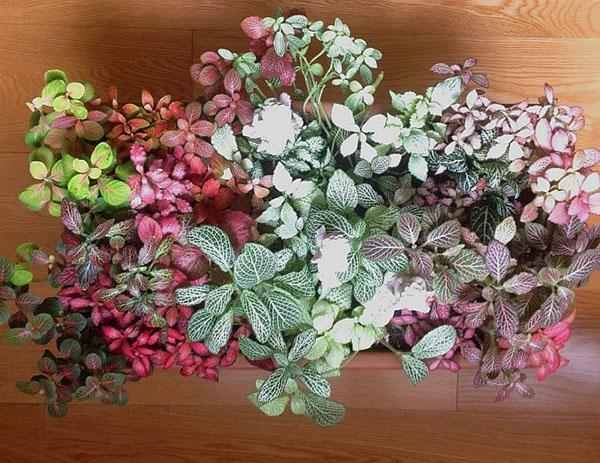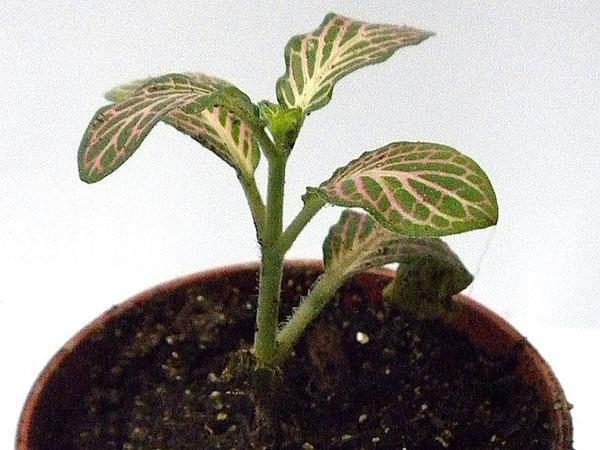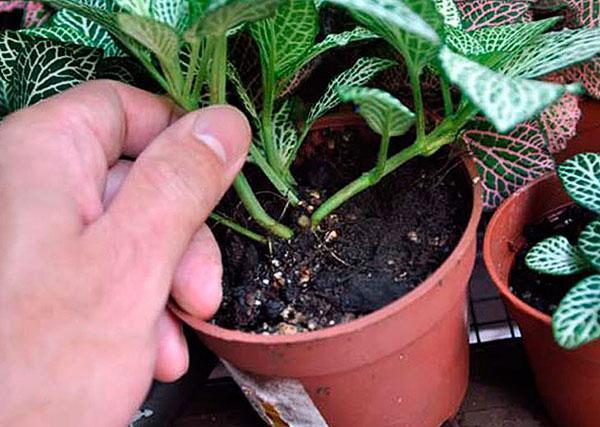Features of the reproduction of Fittonia
 Representatives of the Accantha family, Fittonia are small plants with decorative leaves of various shades and white veins. These are perennial ground cover plants, which have only 10 species.
Representatives of the Accantha family, Fittonia are small plants with decorative leaves of various shades and white veins. These are perennial ground cover plants, which have only 10 species.
A small miracle is not so easy to grow: Fittonia is sensitive to watering, light and other factors. But it's worth it. But how the plant reproduces in indoor conditions, we will now find out.
Reproduction and transplantation after purchase

- After removing the crop from the store pot, lightly shake off the roots, but do not expose them. A plant with an open root system is more difficult to take root.
- Prepare a wide and low pot (such as a bonsai pot) as the roots will be close to the surface. This is the most convenient container for culture. Use a planter for overhead planting.
- Drainage (expanded clay) is indispensable. Fittonia likes high humidity, but not stagnant water.
- To keep the ground always moist, place a tray of water under the plant.
- Constant spraying is important, fittonia withers without moisture.
- Do not put the plant in bright light: the decorativeness of the foliage is lost. Light partial shade will be the most suitable place.
The soil in the pot should not only be damp, but also warm, otherwise the decorative beauty will die.
Secrets of the correct fit
 Reproduction of phytonnia, as well as transplantation, is preferable in early spring. This is a fast growing crop that requires annual replanting and thinning, in which you need to divide the bush:
Reproduction of phytonnia, as well as transplantation, is preferable in early spring. This is a fast growing crop that requires annual replanting and thinning, in which you need to divide the bush:
- Plant the plant in low and wide pots, as it thrives and looks more decorative (groundcover).
- Stagnant water is detrimental to a small crop, do not forget about drainage.
- Transplant the propagated shoots carefully, the shoots of Fittonia are quite brittle.
- Purchase ready-made soil or prepare yourself by mixing leafy earth, humus, peat and sand (3: 1: 1: 1). The soil should be loose and fertile, and retain moisture well.
Due to the rapid growth, replant a young plant annually, an adult - once every 2-3 years, otherwise it will be cramped. The amount of nutrients will decrease, and the fittonia will lose its decorative effect.
Reproduction methods
 Decorative indoor culture propagates in three ways. Fittonia reproduces most easily by dividing the bush. In the spring, carefully separate the root part of the plant and transplant into another container. She takes root well and grows quickly.
Decorative indoor culture propagates in three ways. Fittonia reproduces most easily by dividing the bush. In the spring, carefully separate the root part of the plant and transplant into another container. She takes root well and grows quickly.
It is easy to propagate Fittonia by cuttings:
- In spring, cut off top cuttings (6-7 cm) with 3-5 leaves.
- Plant in damp sand, peat, moss and cover with a bag or glass jar to maintain moisture.
- Another way - just put the stalk in water. Do not pour too much water so that it is better saturated with oxygen. Also cover with a cap.
- Open the seedling regularly and spray. Maintain the temperature at + 20C.
- Fittonia quickly, literally in 2 weeks, gives roots. When roots appear, transplant to a permanent place.
This method is used most often, others also do not present difficulties.
 Reproduction of fittonia by air layers is possible. The shoot, without separating it from the mother plant, drip and strengthen in the same pot. It is convenient to substitute another next to it, so as not to transplant later. Remove leaves from the plant in the place where it was buried. When the twig is rooted, carefully separate it from the mother plant. This is how a young decorative culture appears.
Reproduction of fittonia by air layers is possible. The shoot, without separating it from the mother plant, drip and strengthen in the same pot. It is convenient to substitute another next to it, so as not to transplant later. Remove leaves from the plant in the place where it was buried. When the twig is rooted, carefully separate it from the mother plant. This is how a young decorative culture appears.
Fittonia looks decorative in a group planting. Different varieties have different foliage colors, and this gives the composition an unusual appeal. They look good with small-leaved plants: saline, peperomia, miniature ivy. Fittonia looks beautiful in a small aquarium.
How to prune and shape a bush correctly?
 The problems of growing Fittonia are not breeding, but proper care. The plant is quite demanding to care, and not everyone manages to grow it. To make the bush lush, pinch the shoots. At this point, two new shoots begin to form, and the bush becomes thick.
The problems of growing Fittonia are not breeding, but proper care. The plant is quite demanding to care, and not everyone manages to grow it. To make the bush lush, pinch the shoots. At this point, two new shoots begin to form, and the bush becomes thick.
Over time, the lower part of the plant becomes bare and loses its decorative effect (they say in another way: it grows). A simple technique will help to rejuvenate an old plant - pruning old shoots. Just do not expose the culture completely, as it may die. It is advisable to prune in several stages so that the plant does not experience stress. But it is best to propagate Fittonia by getting a young plant.
Plant several young shoots in one pot at once. So they will grow faster and create the illusion of a lush carpet of green or reddish shades of leaves.
Fittonia is unique in that it is good in both single and group planting. You can create interesting flower and decorative compositions from it, grow it as a miniature plant in an aquarium, and create bonsai. Therefore, buy a plant, propagate it and fantasize, creating unique corners at home.